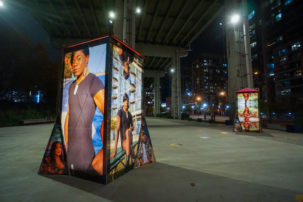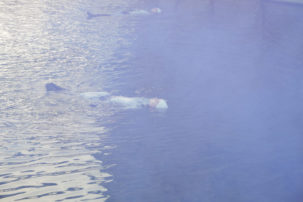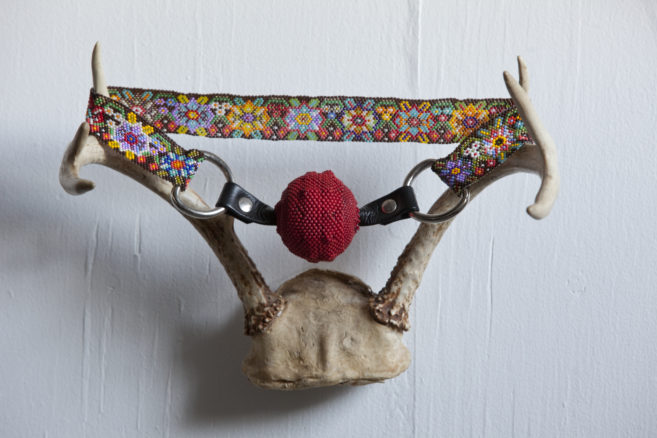The Toronto Biennial of Art has finally come ashore, after years of being proposed, mooted and fought over by rival factions in the city. It has tethered itself along the shoreline, from east of downtown to Mississauga, using the Toronto Purchase as its thematic anchor. Siting its two main exhibition halls there, the Biennial has also ventured inland through various downtown partners. But “The Shoreline Dilemma” is what the Biennial calls itself, not “The Suburban Solution,” so the Art Gallery of York University is its one lonely suburban outpost.
Curators Candice Hopkins and Tairone Bastien have blended together the phenomenon of what is also called the coastline paradox and the shoreline perimeter of the Toronto Purchase as if they were the crest and trough of a single wave. It’s a wave that sculpts the serried shoreline terrace of Adrian Blackwell’s Isonomia in Toronto? (harbour) (2019), a sculpture-cum-amphitheatre built from harvested Toronto ash that architecturally sweeps around to form a bay as if a natural site for discussion. And so it is, as many of the artists are actively involved in programming their installations for the duration of the Biennial. Having taken on one meaning of Toronto’s Indigenous name as a meeting place, Blackwell’s installation opens the exhibition at the decommissioned Volvo dealership at 259 Lake Shore Boulevard East. The work is surrounded—one could say witnessed—by the “revolutionary wearables” of the legendary, though recently rediscovered, Jae Jarrell and the stunning Duratrans LED fire-boxes of Dana Claxton, portraits of friends, whose faces are obscured by another identity posed rather by kinship and exchange, as the sitters were asked to wear their gifted cultural belongings—itself pointing to the idea of generosity operating throughout the Biennial. In their silent conversation, Jarrell’s and Claxton’s works signal Black and Indigenous pasts, presents and futurities—and perhaps orient our way through the two possible entries into the exhibition.
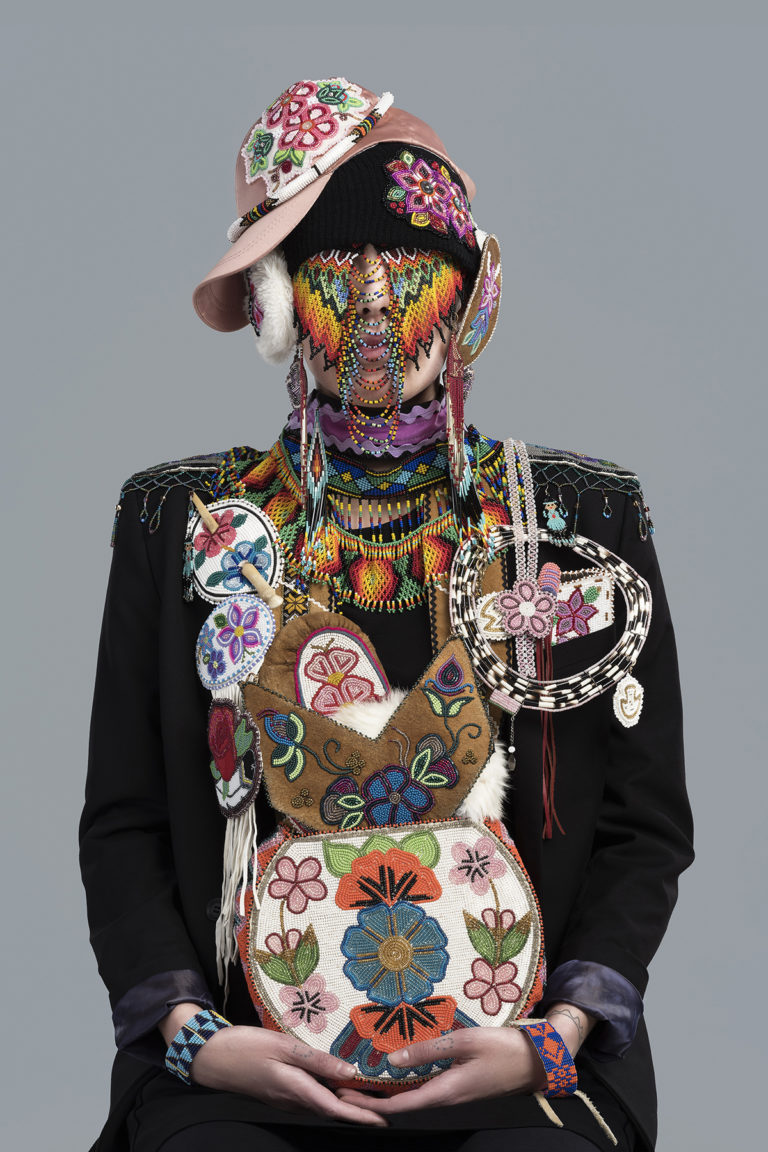 Dana Claxton, Headdress-Jeneen, 2018. LED fire-box with transmounted lightjet duratrans. Courtesy the artist.
Dana Claxton, Headdress-Jeneen, 2018. LED fire-box with transmounted lightjet duratrans. Courtesy the artist.
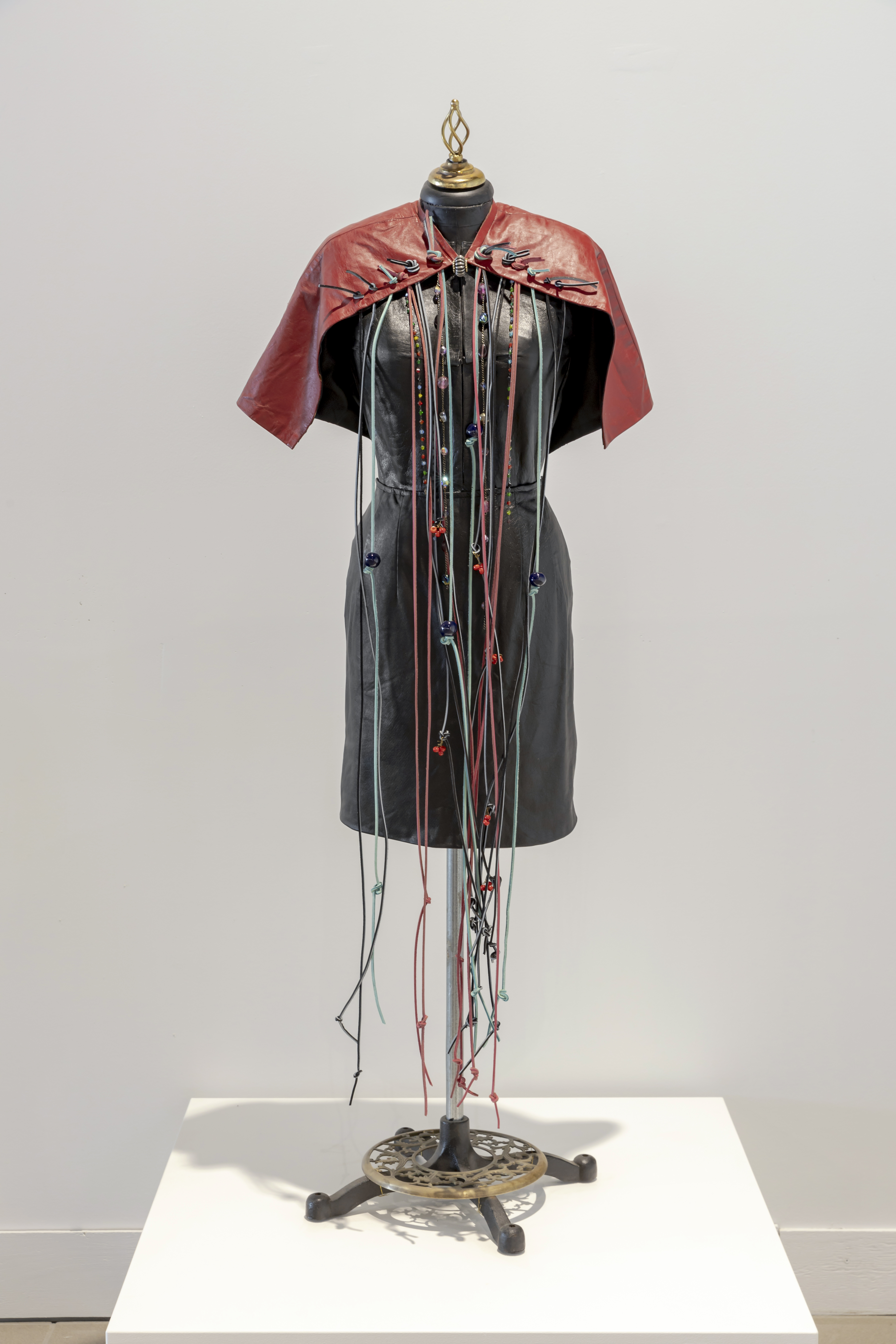 Jae Jarrell, Ornaments of Reflection, 2019. Leather, metal beads and thread, 1.52 m x 76.2 cm x 45.7 cm. Courtesy the Toronto Biennial of Art. Photo: Toni Hafkenscheid.
Jae Jarrell, Ornaments of Reflection, 2019. Leather, metal beads and thread, 1.52 m x 76.2 cm x 45.7 cm. Courtesy the Toronto Biennial of Art. Photo: Toni Hafkenscheid.
The exhibition threads its way through the two sides of the building to be knotted together by a temporarily “empty” space that interrupts our circulation halfway. This is no accident, but a reminder that this “programming and learning hub” is also the heart of the Biennial project, or at least an equal part of it, so its curators should be named too: Ilana Shamoon, Clare Butcher and Myung-Sun Kim. Typically, programming is considered secondary to the artworks of a biennial and is not reviewed since it also unfolds over its duration and beyond. But the successes of programming here, I believe, will be important for the Biennial to fully take root in this place.
The question addressed—both by programming and the Biennial as a whole—is: “How do we learn and listen with the lake?” The question helped shape the organization of the Biennial as a whole, even before we walked through its doors, by way of actions that we do not “see” in process, such as the Indigenous lens achieved through commissioning Ange Loft to write a foundational Toronto Indigenous Context Brief. Another example: The Biennial is almost entirely run by women. And curators have been hired to extend their gained experience to the 2021 Biennial. Continuity is crucial. Doing it right, for Toronto, and doing a biennial differently: these will be the two hallmarks of this inaugural iteration. These are two very good reasons to respect what is being attempted here.
Learning from the water while actually floating on it is the aim of Elder Duke Redbird’s artwork Wigwam Chi-Chemung (Big House Canoe) (2019), an Indigenous interpretative learning centre located in a moored houseboat, adorned in Woodland style by Redbird and Philip Cote, with Elder Redbird present. And listening with the lake is a means to meld the movement of water, its ability to carry sound, and music’s enveloping temporalities. So some of the more affective works were auditory, such as Raven Chacon, Delf Maria Hohmann and Allison Cameron’s Harbour Symphony (2019), where working boats and pleasure crafts tooted their horns while plying the waters of the harbour in the real time of their day-to-day activity; and Althea Thauberger and Kite’s musical performance Gift to the Water (2019), presented in partnership with the naval band of HMCS York. And against expectations of what we were to see in the giant geodesic dome of Ontario Place’s Cinesphere, it is the sound works (by Marguerite Humeau and Pauline Oliveros, among others) of Charles Stankievech’s curated program, The Drowned World, that effectively envelop us in deep time in an aural, aquatic and amniotic regression in the dark.

Althea Thauberger and Kite, Battle Cry (Gift to the Shell Ensemble) (still), 2019. 2-channel video with 6-channel audio. Commissioned by the Toronto Biennial of Art. Courtesy the artists.

Lisa Reihana, Tai Whetuki—House of Death Redux, 2016. 2-channel UHD video, 16 minutes. Courtesy the artist and Artprojects, Auckland.
Who knows how much the two official sites, kilometers apart, are entwined, as some artists appear in both venues, as in quantum entanglement’s paradoxical correlation of pairs of particles across a distance. Needless to say, they strike different stances. At the Small Arms Inspection Building in Mississauga, in a lovely, preserved 1940 modernist industrial structure encased by large windows, the light-infused installation is left open with no walls constructed—and is lovely in turn. The works dialogue in a way not possible across town, reverberating their themes, which are mainly environmental in the large sense.
Antipodal assonances resonate, for instance between Māori and Inuit artists on issues of culture, contact and conflict. The Inuit film collective Isuma has an on-shore as well as an off-site presence in a major show at the Art Museum at the University of Toronto. Similarly, Lisa Reihana has a compelling projection at 259 Lake Shore Boulevard East and a stunning installation at the Art Gallery of Ontario. The latter, based on neoclassical French scenic wallpaper—more European garden idyll than accurate representation of Captain Cook and other explorers’ South Pacific first contacts—scrolls by in a huge panorama with multiple isolated realistic vignettes set within its flattened artificial decor. In Reihana’s corrective representation, it is no less idyllic, but also no less real, in depicting Polynesian culture prior to the arrival of the British. Telling it like it is about everyday life means dark secrets too. Daughter of Pitseolak Ashoona and mother of Annie Pootoogook, Napachie Pootoogook does both: picturing everyday Inuit activities and, in intricately patterned black-and-white images, stories of murder and abuse.
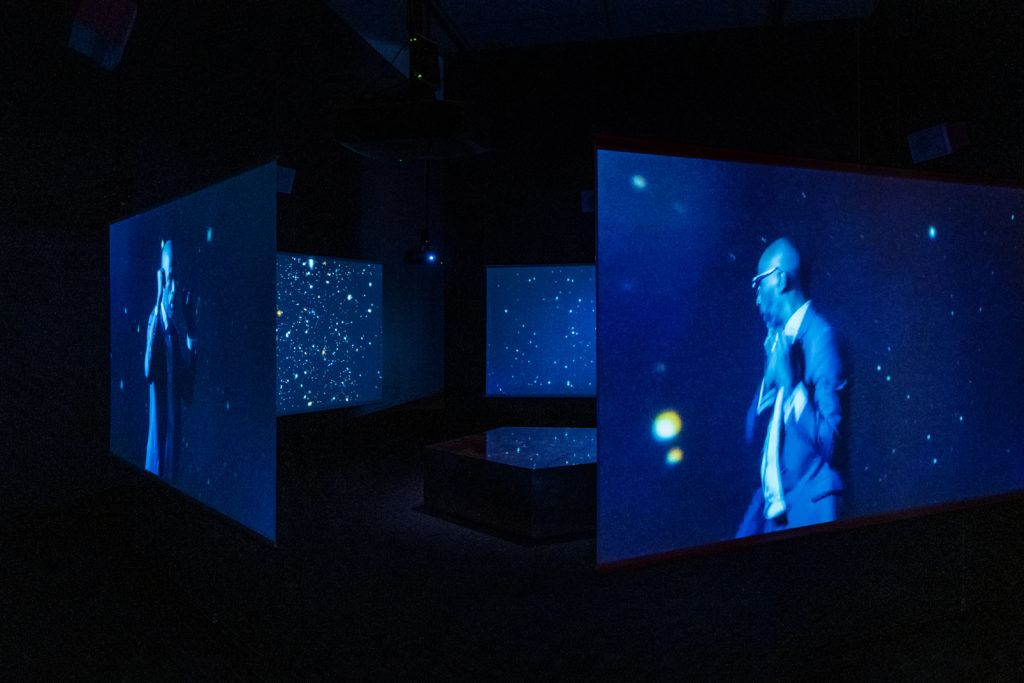
Installation view of Caecilia Tripp's "Going Space and Other Worlding" at Art Gallery of York University as part of Toronto Biennial of Art. Photo: Yuula Benivolski.
Not only do we negotiate distances in this biennial but also time scales: past, present and future, which the Anthropocene has brought into unstable proximity. Of course, with the uncertainties of climate change, the future looms large in many works. Syrus Marcus Ware’s Antarctica (2019) is an installation masking a periodically performed playlet where a future band of Black researchers is stranded on that climate-altered continent. Even if it breaks down the fourth wall by inviting viewers into its staging, the play in its prose is no match for poetic speculation, even if in reality one is no more effective than the other. Maybe it’s the technological form of presentation; Ware’s media wall at Ryerson Image Centre, Ancestors, Can You Read Us? (Dispatches From the Future) (2019), fares better for such futurological representations. Speculations on cosmological futurity are enacted several times just across the way from Ware at 259 Lake Shore Boulevard East in Caecilia Tripp’s Interstellar Sleep (2019) and in the exhibition “Going Space and Other Worlding” at the AGYU. There, inspiringly constellated in relation—to take up one of the Biennial’s themes—Tripp joins Jae Jarrell, veteran of the Black Arts Movement, whose wearable sculptures stitch together art and Black liberation politics. A Glissantian adventurer, Tripp moves between art and science, sound and image, spoken word and dance, in dreamy cosmological projections that take us, and their Black protagonists, from the Earth’s molten interior to the gassy interstellar beyond. (One of the spoken-word contributors to Tripp’s AGYU works, Borelson, reappears as a floating astronaut in her Interstellar Sleep, then is found down the corridor in Bárbara Wagner and Benajmin de Burca’s RISE (2018), before participating in the Biennial’s Storytelling program—which shows how entwined this biennial sometimes is!)
Back on Earth and at the Biennial again, it is a question of how the past enters the present and how the present reckons or reconciles with it. Maria Thereza Alves’s Garrison Creek (2019) is a reminder that Toronto buried many of its waterways—but, living here, this is information we already know. Meanwhile at Riverdale Park West her earth-work-cum-water-work, mimicking at tiny scale the meander of the Don River before its flow was rationalized into a straight line at the beginning of Toronto’s industrial era, is more a tiny footnote to the river itself and less than underwhelming in its poetics. On the other hand, at 259 Lake Shore Boulevard East, the prosaics of Luis Jacob’s The View from Here (Library) (2019)—the other half of which is at Union Station—is surprisingly evocative, though it is but a display of publications on Toronto. Its sprawling, 100-foot-long chronological “timeline” housed in elegant steel-supported vitrines is a telling montage of attitudes toward the city over the decades, its development shown merely through the covers of pamphlets, books and reports. (Were there any good outcomes of “slum clearance”?) Though historical, Jacob’s display tells us something about here, now. Removed in time (1992) and place (South Africa), and typically mailed in to the show, Moyra Davey’s photographic series Gold Dumps and Ant Hills (1992/2019) does not. If the latter partly is about mining, New Mineral Collective’s (Emilija Škarnulytė and Tanya Busse) video Pleasure Prospects (2019), which images some of the technologies of mineral exploration, is more pertinent. If Davey compares insect and human excavation, New Mineral Collective fully implicates us in the actions of today’s extractive industries on our “perforated landscapes.” This is a delicate task given the unusual number of mining sponsors of the Biennial. (Three-quarters of the world’s mining corporations are headquartered in the tiny territory of Toronto’s fortress financial district, while the Toronto Stock Exchange supplies 60 per cent of global financing to the industry.)

AA Bronson, A Public Apology to Siksika Nation, 2019, a multi-media project with publication, installation and performative components in several stages; Adrian Stimson, Iini Sookumapii: Guess who’s coming to dinner?. Commissioned by the Toronto Biennial of Art, 2019. Photo: Toni Hafkenscheid. Courtesy the Toronto Biennial of Art.
Pertaining to collective pasts and their implications today, one of the most remarkable collaborations—or, rather, collaboration-as-conciliation—is that between AA Bronson and Adrian Stimson, arising from the stupendous coincidence that Bronson’s great-grandfather, an Anglican missionary on the Siksika (Blackfoot) reserve in Alberta, was an architect of the residential school system, and Stimson’s great-grandfather was Old Sun, the Siksika chief. This may be a heavy burden for Bronson to bear, but not nearly as heavy as the one borne by residential school survivors, of whom Stimson is one. Bronson’s apology—A Public Apology to Siksika Nation—was performed at the Biennial twice, once during the preview and a day later at the opening, witnessed by the art world, both times in front of a number of Siksika residential school survivors and Stimson, who accepted the apology. It will be repeated again on the Siksika reserve. It is confusing to know which is the rehearsal, which the apology, and which the performance because a performative utterance, of which an apology is one, has quite strict rules. But Stimson took the proposal, project and procedure seriously, so you have to respect it. He responded to Bronson’s archival timeline presented opposite with a beautiful, moving, multi-part installation all of which he created in consultation with residential school survivors and Siksika leaders. Together, Stimson and Bronson have created a consequential artwork.
You might think such white settler expiation would fall under the admonition of New Red Order’s tongue-in-cheek, over-the-top Never Settle (2019) installation next door, with its recruitment video aimed at white people as allies and another fictionally documenting their therapeutic conversion, but I don’t think that is the case here.

The New Red Order (NRO), Never Settle, 2019. Mixed-media installation. Courtesy Toronto Biennial of Art. Photo: Toni Hafkenscheid.
It seems niggling to make a complaint, but the distribution of work on the sales versus the services sides of the old Volvo dealership inflects our appreciation of the art—the former is a clean space with built white walls, and the latter is an unconditioned garage. While unrenovated industrial space has its charms, sometimes work can accommodate it, as in Susan Schuppli’s projection Learning From Ice (Part I: Ice Cores & Interviews with Ice Core Scientists) (2019); at other times the surroundings diminish the work, such as Bárbara Wagner and Benjamin de Burca’s RISE (2018). This was an important film installation to bring to the Biennial as it featured suburban Scarborough and Jane-Finch spoken word poets and was fully shot underground in the new TTC Line One subway extension. Be that as it may, while this work was not commissioned by the Biennial, many works were, which is a large achievement that visiting artists take back into the world after their temporary residence in Toronto. What remains for Torontonians to see in the next iteration is that the Biennial is more than a shoreline proposition but inclusive of the whole city—the suburbs too.

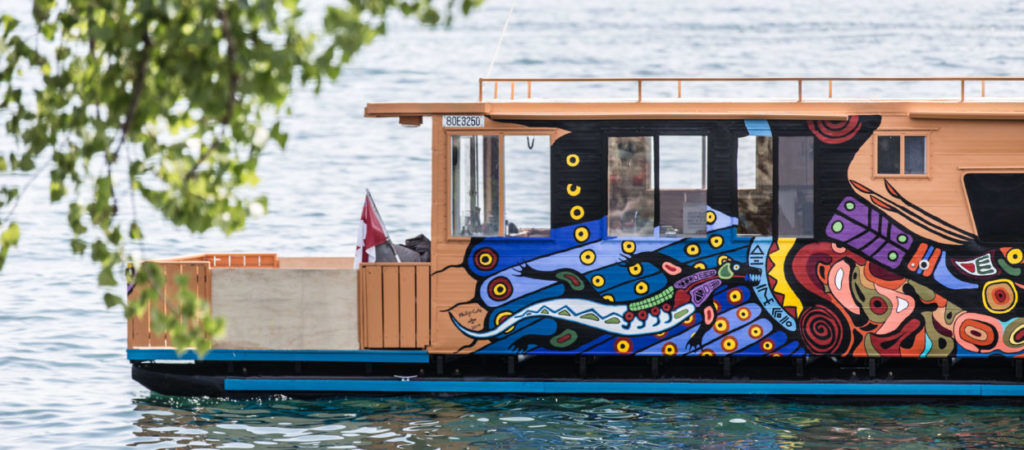 Elder Duke Redbird, Wigwam Chi-Chemung (Big House Canoe), 2019. Installation view of 40-foot pontoon houseboat painted by Phil Cote and Duke Redbird. Courtesy the artist, Elijah Nichols and Myseum of Toronto.
Elder Duke Redbird, Wigwam Chi-Chemung (Big House Canoe), 2019. Installation view of 40-foot pontoon houseboat painted by Phil Cote and Duke Redbird. Courtesy the artist, Elijah Nichols and Myseum of Toronto.

